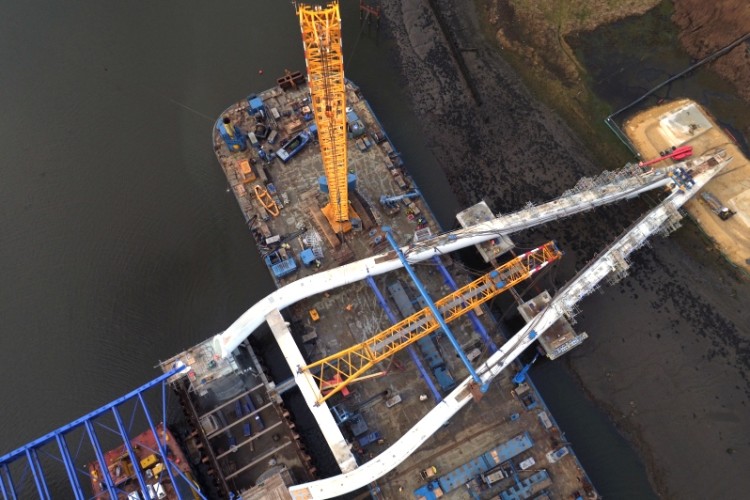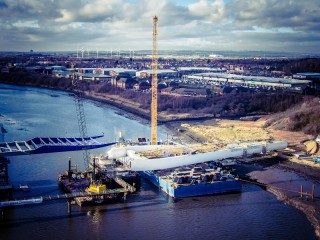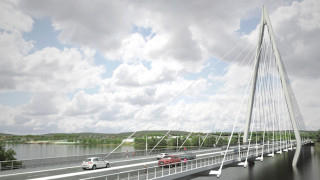Belgian specialist lifting contractor Sarens will begin raising the 100-metre high, 1550-tonne pylon to vertical at around 8am on Friday 10th February 2017. It is being billed as the biggest operation of its kind since the London Eye was lifted up (by Sarens’ arch rival Mammoet) in 1999.
Project managers are expecting crowds of thousands to be linking the river banks to witness the precision strand-jacking operation.
Northumbria Police has issued a warning to drone operators who flout the law during the two-day raising of the pylon. Sergeant Mark Boustead of Northumbria Police’s operations department, said: “The public need to know that if we identify them as flying a drone in this area they could be prosecuted. Flying these types of aircraft within 150 metres of a congested area is a criminal offence and may contravene air safety legislation. Those found violating that rule could face criminal prosecution. Not only could flying drones in the area affect the installation of the centrepiece, but it could put members of the public in the area at risk.”
Stephen McCaffrey, project director for Farrans Victor Buyck Joint Venture (FVB), which is Sunderland City Council’s main contractor for the £120m project, said the raising of the pylon was an exciting time for all involved. “We have been working towards this point since we broke ground on the project 20 months ago,” he said, “so I think we are all looking forward to seeing the centrepiece take its final position over the river.
“Lifting something of this weight and size is complex and takes a lot of planning and expertise. This operation has been calculated to the millimetre, so it will be very slow and measured – it cannot be rushed. There have been a lot of things to get in place, and we also needed the right weather window, but we are ready.
“Engineering achievements of this scale don’t happen very often, so I think it will be quite something for people to watch – even for us working on the project. It will take at least 24 hours to complete, so hopefully people will have a chance to see it.”
The movement and raising of the pylon is being carried out by Sarens in partnership with FVB. Engineering director Carl Sarens said: “It’s a complex project, with a vast range of technical challenges, particularly around the raising of the pylon, but once complete it will obviously have a huge impact on Sunderland. Bridges connect communities, they open up land for development and they very often create a new sense of pride among people. The centrepiece is a magnificent structure, so we are looking forward to lifting it into place.”
The new bridge will link Castletown to the north of the River Wear with Pallion to the south, and will have dual two-lane carriageways for vehicles, as well as dedicated cycle and pedestrian routes. It will enhance public transport, as well as significantly improve the important transport links to the city centre and Port of Sunderland from the A19 and A1. It is on track to open in the spring of 2018.
How the lift works
Giant hinges have been used to attach each leg of the pylon to the tusks that are built into the riverbed foundations to support the pylon. The hinges are fixed together to hold the pylon in place and will enable the pylon to be rotated into a vertical position.

The backmast – a 50-metre high yellow crane boom has been temporarily fixed to the pylon for the raising operation. It is being used to create an angle between the cables and the top of the pylon, which will allow the pylon to be pulled upwards. The crane boom has been taken from Sarens’ SGC-120 super crane, nicknamed ‘Big Benny’, which is one of the largest cranes in the world, with a lifting capacity of 3,200 tonnes.
The cables used to pull the pylon into position are connected to a spreader beam that is connected to the top of the pylon. They pass through four hydraulic strand jacks, anchored 30 metres into the ground on the south side of the river. The cables are drawn through the jacks in order to pull the pylon into a vertical position.
Similarly, there are two hydraulic strand jacks located on the north side of the river that act as a counter-balance to those on the south side, to ensure a steady operation.
The strand jacks, initially with the backmast, will be used to raise the pylon – up through most of the lift – until the pylon reaches an angle of about 70 degrees, which will be three-quarters of the way through the operation.
At this point, the backmast will automatically disconnect from the cables, and the strand jacks will continue to draw the cables through, pulling the pylon up for the remaining 20-degree rotation to its final vertical position.
As the pylon approaches its final position, the backmast will be retracted to stand vertically alongside the pylon and the north side cables will be tensioned to ensure the pylon is supported from both sides until it is fully secured.
Once the raising is complete, the backmast will gradually be removed and lowered to the ground and work will begin to secure the pylon permanently to the tusks. It will take three weeks to ensure the pylon is fixed in place.
Each leg of the pylon will be fixed to one of the tusks with 20 bolts, with each bolt measuring 6 metres long by 65mm in diameter. A total of 40 bolts will secure the pylon in position.
After the bolts are fitted, tensioned and the gaps grouted, the base of each leg of the pylon will be filled with reinforced concrete. When all of that is complete, the rigging and cables used for the raising will be released. The pylon will then become free-standing until the bridge deck is launched into place in the spring and the cable stays connecting the bridge deck to the pylon are positioned and secured over the summer.
Got a story? Email news@theconstructionindex.co.uk





